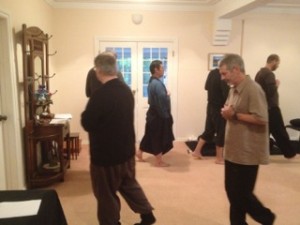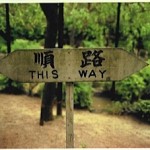
Zen meditation practice points towards an unconditional awareness of internal commentary, judgements, concepts and self-created boundaries.
Zazen
There are three meditation practices we focus on:
1. Awareness meditation through focusing on our breath.
2. Awareness meditation through focusing on the Koan Mu.
3. Shikantaza, (just sitting) an open awareness meditation focusing on what arises in the mind and the subsequent letting go of what has arisen.
 Kinhin
Kinhin
Kinhin is a mindfulness excercise that takes Zen from the cushion into our everyday world. It is a walking meditation that combines mindfulness practice and awareness.
Dokusan
Dokusan is a confidential face to face meeting between a student and a teacher.
Anyone who is not in a formal student-teacher relationship is welcome to discuss their practice with a teacher. (Note that not all teachers teach in all locations.)
If a practitioner has determined to become a student of Zen, usually after having completed the introduction to Zen lectures and after having established a regular meditation practice, a formal request can be made to become a Zen student of a particular teacher. The process is quite simple. Students approach the teacher they want to work with and ask to become a student. Once the teacher accepts the student, a practice path is then developed to suit the aspirations of that person. They then work with their teacher exclusively. A student can terminate the relationship at any time by simply discussing the matter as appropriate.
Koan practice
Koan practice is a skillful means by which a student continues to liberate themselves from the many layers of acquired conditioning. Koans are usually phrases or dialogues between masters and students that were collected in ancient China and have survived until now. Koans cannot be intellectually grasped but only “understood” through direct experience. Everyday life is Koan Practice.
Sesshin
Sesshin is for practitioners who are comitted to intensive Zen practice. They vary in length from 2 to 7 days. See our calendar of events for a full schedule. Single days of intensive practice are held monthly.
One of the many benefits of being a member of Sun Mountain Zen is to be able to participate in the yearly Sesshin. This 5 or 7 day, in-house meditation practice is the highlight of our annual activities.
Many Zen students only begin to take their practice seriously after the experience of a Sesshin. This prolonged period of zazen is a good opportuntity for participants to realise their true nature.
Do not miss a Sesshin!
Zen Etiquette
At Sun Mountain Zen, the marketplace is our Zendo including all the rituals and practices in which we participate. The marketplace is also every moment of our everyday lives— with family, work and in the wider community. All of these afford a place and time to practise.
In order to create a suitable environment where we can practise zazen together, there are Zendo traditions:
- Be on time. i.e. before the sitting commences. Allow yourself time to get ready and to settle into your place.
- Consider coming 20 minutes earlier to help others setup the Zendo.
- Before entering the Zendo, place your shoes, waterbottle, bags etc, outside the Zendo neatly in the space provided.
- Upon entering the Zendo, gassho (bow) towards the Butsudan
- Proceed to your place. (Do not cross the Zendo diagonally)
- Gassho first towards the cushion / chair and then toward your fellow sitters.
- Settle on your cushion. Be ready by the time of the warning clappers and certainly by the first gong.
- Begin your practice.
- If you need to leave the Zendo, do so during kinhin quietly. Every distraction is a potential interruption to someone’s practice. Walk slowly, quietly and deliberately. Do not make unnecessary noise. Be mindful and considerate.
- When moving on your cushion or chair, gassho before the move and after the move. This is to be mindful of the potential disturbance you have just created.











